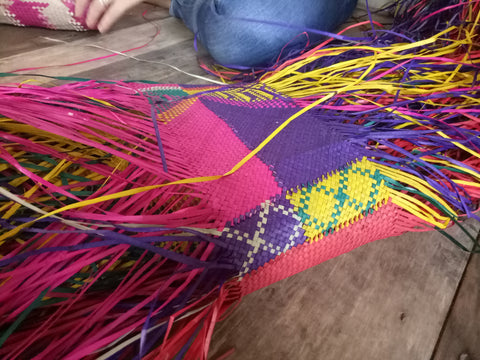International Women's Day

To preserve them and take pride in them is saying YES to sustaining age-old beauty & sustainable practices. (Pictured above: Tausug handwoven mats)
In each weave, we find stories of struggle, life cycles, elements of everyday life, symbols influenced by historical trade routes and so much more that we discover each time we dare to delve deeper. In many of the communities we work with, one unifying factor we see is that weaving is predominantly done by women and they usually weave together or at home in silence or quiet chatting. (Pictured below: Yakan weavers)

Prior to beginning a weave, there are rituals done to provide guidance and inspiration during the weaving process. It is, in fact, a tedious process: from setting up the looms to completing the design. Each thread or piece of grass is counted by hand and each line in the weave is a thoughtful orchestration of movement to create the pattern on the panels. (Pictured below: Kalinga Laga and Ilocos Inabel weaving steps.)




While many of the ready-to-wear items created today are machine made with designs computer-generated, indigenous weaves are nature-inspired intricate geometric patterns. (Pictured below: Sama Bajau handwoven mat. Please contact us to commission work.)

Much of it is encoded subconsciously in the indigenous artisan's mind and drawn from generations of maintaining that connection to nature, whose geometry and color combinations have been perfected over millions of years of evolution. It's no wonder that when indigenous artisans look for design inspiration, they look to flowers, trees, mountains, rivers and even the trail of snails, the butt of a bat (yes, that is beauty as well... more on that later) and the pattern of falling rain. Today, we call it biomimicry, which has been a design practice of indigenous women for hundreds, perhaps thousands, of years. It is about time we give a nod to these women who have passed this wisdom on, through generations of artisans. (Pictured below: Mangyan elder teaches students to weave a traditional "ramit" - a multipurpose textile. Available soon. Contact us to pre-order.)
Support their work and affirm their wisdom by purchasing their products here: https://filiology.com/collections/all
Philippine residents may avail of FREE nationwide shipping via www.shopee.ph/filiology.


Leave a comment
Please note, comments must be approved before they are published